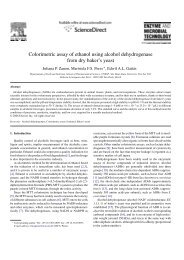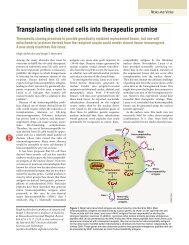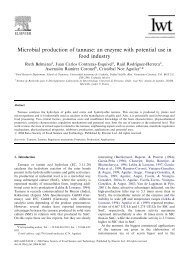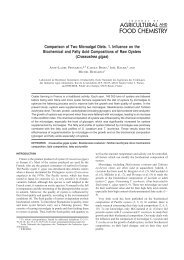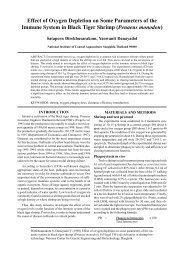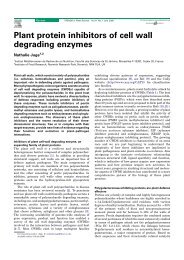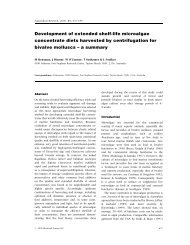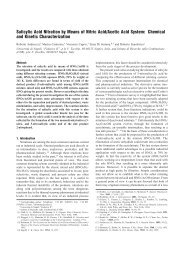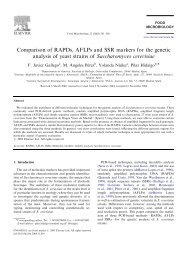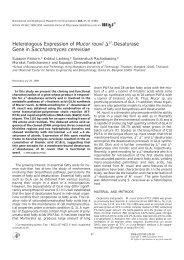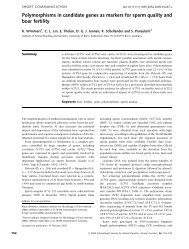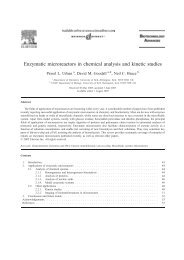Transparent communication strategy on GMOs: Will it change public opinion?
Transparent communication strategy on GMOs: Will it change public opinion?
Transparent communication strategy on GMOs: Will it change public opinion?
Create successful ePaper yourself
Turn your PDF publications into a flip-book with our unique Google optimized e-Paper software.
Biotechnology<br />
Journal<br />
si<strong>on</strong>, that, since the <strong>public</strong> is irrati<strong>on</strong>al, efforts to provide<br />
informati<strong>on</strong> and educati<strong>on</strong> are a waste of time and m<strong>on</strong>ey,<br />
or that the <strong>public</strong> cannot make “appropriate” decisi<strong>on</strong>s<br />
about biotechnology. The <strong>public</strong> has a much wider scope<br />
and is able to evaluate risks versus benef<strong>it</strong>s. This raises or<br />
hypothesis 3: It can be c<strong>on</strong>cluded, that Europeans are<br />
not less innovati<strong>on</strong>-friendly, however, risks are not communicated<br />
appropriately and EU-c<strong>it</strong>izens react oversens<strong>it</strong>ively<br />
to them.<br />
5 Target-oriented <str<strong>on</strong>g>communicati<strong>on</strong></str<strong>on</strong>g>s<br />
As described above, some of the main reas<strong>on</strong>s for the low<br />
acceptance of GM foods in Europe are to be found in a<br />
trust gap into inst<strong>it</strong>uti<strong>on</strong>s and larger multinati<strong>on</strong>al companies,<br />
as well as in a low level of awareness <strong>on</strong> the perceived<br />
benef<strong>it</strong>s of this new technology. In this respect,<br />
pol<strong>it</strong>icians play a significant role in supporting pessimistic<br />
and emoti<strong>on</strong>al-driven debates instead of taking<br />
an informative and educative approach, thereby fulfilling<br />
the social c<strong>on</strong>science they possess.<br />
Therefore, new <str<strong>on</strong>g>communicati<strong>on</strong></str<strong>on</strong>g> strategies may be developed,<br />
which do address those issues. Communicati<strong>on</strong><br />
experience has shown that the following factors are of significant<br />
importance:<br />
– Credibil<strong>it</strong>y<br />
– Translati<strong>on</strong> of complex technical informati<strong>on</strong> into easily<br />
understandable language<br />
– Attractive, target-oriented “c<strong>on</strong>d<strong>it</strong>i<strong>on</strong>ing” of the informati<strong>on</strong><br />
w<strong>it</strong>h opti<strong>on</strong>s for interactive feedback<br />
– Value-free reporting – the <strong>public</strong> is capable to assess<br />
informati<strong>on</strong><br />
Choosing and employing the most appropriate <str<strong>on</strong>g>communicati<strong>on</strong></str<strong>on</strong>g><br />
tools for a specific target group requires a clear picture<br />
of “the <strong>public</strong>”. It is, however, a rather complex ent<strong>it</strong>y,<br />
influenced by various factors, such as differing values,<br />
wishes, fears, social rankings, the cultural envir<strong>on</strong>ment,<br />
ethics, buying behaviors and more. In other words: the<br />
broad “<strong>public</strong>” as such doesn’t exist, and can be divided<br />
into specific subgroups. This is an important <str<strong>on</strong>g>communicati<strong>on</strong></str<strong>on</strong>g><br />
issue, as some c<strong>on</strong>sumers actively seek informati<strong>on</strong><br />
and make trade-off between risks and benef<strong>it</strong>s, and<br />
others inher<strong>it</strong> att<strong>it</strong>udes or opini<strong>on</strong>s passively from the envir<strong>on</strong>ment<br />
[15].<br />
In a specific cultural envir<strong>on</strong>ment certain fundamental<br />
values, percepti<strong>on</strong>s, preferences and behaviors are<br />
adopted, transferred to the next generati<strong>on</strong>, and do evolve<br />
over time. Because of the complex<strong>it</strong>y and timely alterati<strong>on</strong><br />
of these factors, market research developed various approaches<br />
for a clearer segmentati<strong>on</strong> of c<strong>on</strong>sumers and<br />
several models based <strong>on</strong> statistical informati<strong>on</strong> do exist.<br />
Starting from the sociological described target groups,<br />
psychological and also recently neurobiological based differentiati<strong>on</strong>s<br />
are being made, leading to target group ty-<br />
1144 © 2007 Wiley-VCH Verlag GmbH & Co. KGaA, Weinheim<br />
Biotechnol. J. 2007, 2, 1141–1146<br />
pologies [16]. A market-research based and simplified<br />
classificati<strong>on</strong> is offered by Herbst [17], a scheme that discriminates<br />
the “<strong>public</strong>” into three types:<br />
Type 1. Martin, the avoider<br />
Martin, the avoider is characterized by not pro-actively<br />
searching for informati<strong>on</strong> and w<strong>it</strong>hout undertaking cr<strong>it</strong>ical<br />
analyses. He avoids theoretical c<strong>on</strong>troversies. Typical<br />
are pessimistic thoughts and views, such as „What can<br />
we generally eat safely nowadays?”<br />
Type 2. Svenja, the passive<br />
Hed<strong>on</strong>istic views and att<strong>it</strong>udes are characteristic for<br />
Svenja, the passive. Being 22, student and single, she<br />
wants to subsist healthy. She looks at pictures and has<br />
str<strong>on</strong>g emoti<strong>on</strong>al reacti<strong>on</strong>s. She is – similar to Martin – not<br />
actively seeking informati<strong>on</strong> and is not greatly willing or<br />
able to estimate risks <strong>on</strong> her own.<br />
Type 3. Dörte, the active




